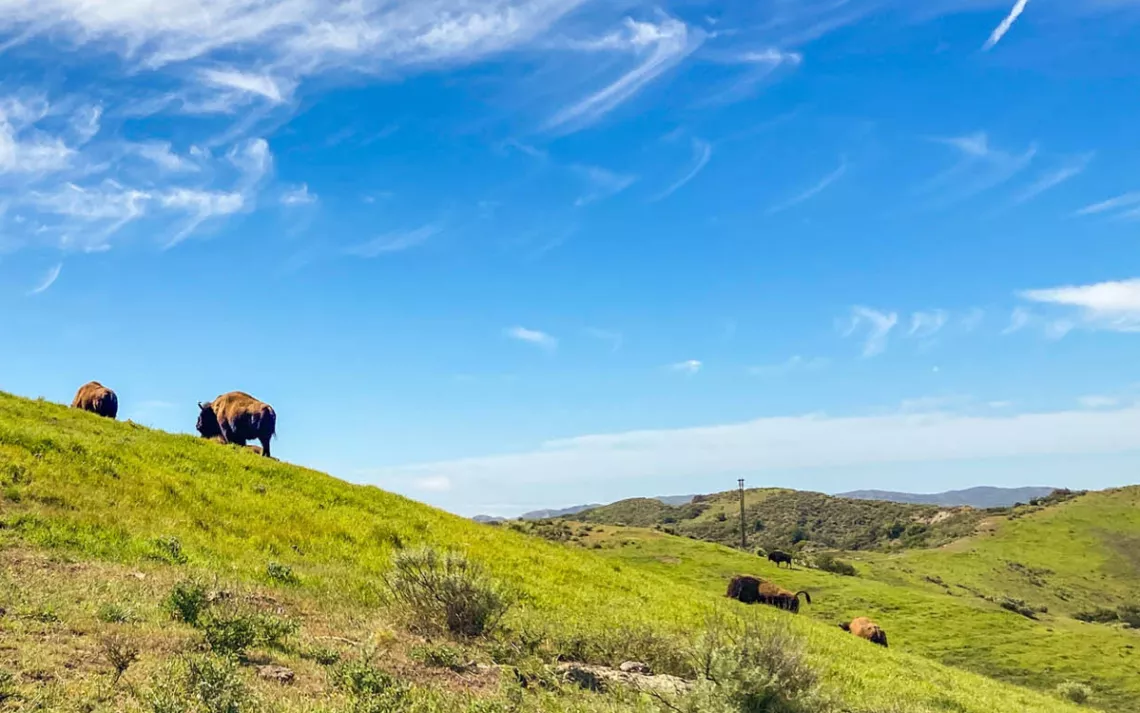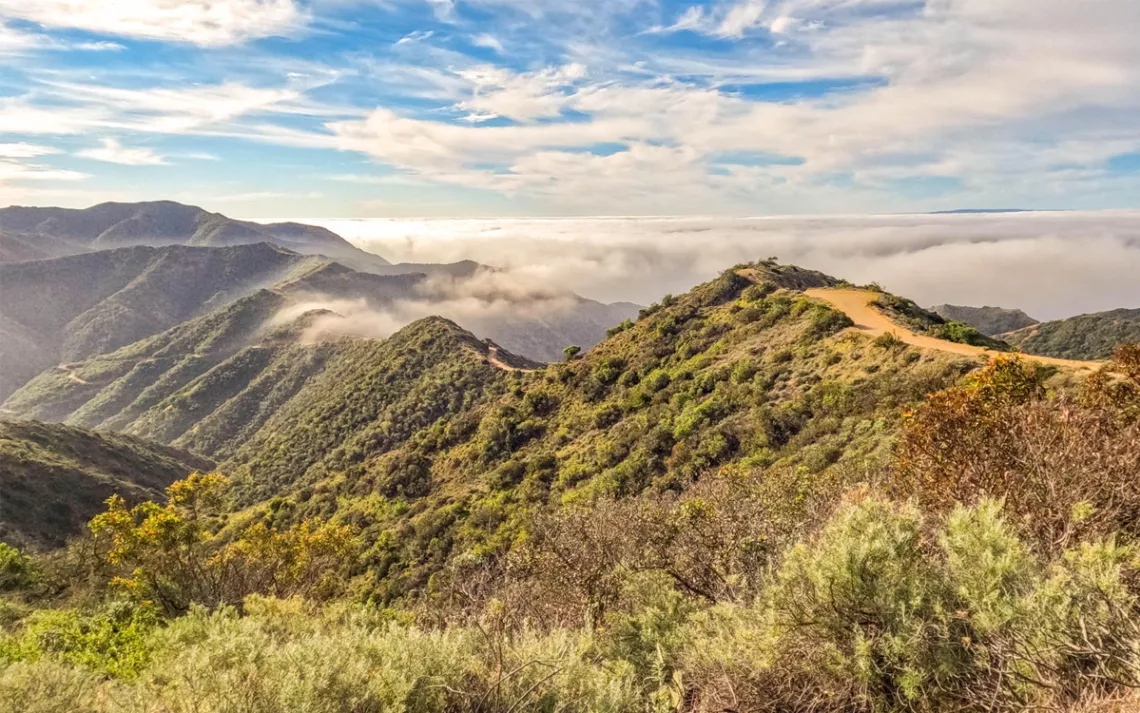Where the (Non-Native) Bison Roam
A bison colony abandoned by the 1920s movie industry is thriving off the coast of Los Angeles

A few of the bison that reside on Catalina Island. | Photo by Alisha McDarris
On Santa Catalina Island, I rose with the sun. A long day on the Trans Catalina Trail lay before me, and I was eager to set off from Avalon, a Mediterranean-style tourist enclave near the southeastern tip of the island. The cool morning air was welcome motivation to put my pack on my back and boots on the trail. As I crested the high hills towering over Avalon Bay, I was just 25 miles or so from Long Beach but removed enough to feel like I was in another country—not a skyscraper in sight through the haze and distance. The only hint that Los Angeles existed was a few seafaring vessels to the east that inched into the void, long white tails in their wake. To the west, clouds spilled over the mountain passes, marching over green peaks.
As I checked off miles with my friend and hiking companion, I kept my eyes on the rolling landscape studded with cacti and low scrub, green foliage, red dirt, and white rock, scanning for signs of local wildlife. Finally, as we rounded a bend in the trail, we spotted it: a huge, hulking, hairy brown mass slowly meandering in our direction on the same worn path. Our first Catalina Island bison.
We stopped to gaze in amazement, close enough to appreciate the creature’s size and grandeur but far enough away (25 yards is the minimum recommended distance when it comes to people and bison) to be comfortably out of danger. Still, as we raised our cameras, we scanned our immediate surroundings for potential escape routes.
As if on cue, a Catalina Conservancy truck appeared around a bend and bounced up the hill toward the animal. Later, I learned that the rangers employed by the conservancy more often deal with hikers with dehydration than bison-hiker conflict, but it just so happened that this ranger was cruising nearby, saw a bison and hikers on a collision course (albeit a painfully slow one), and intervened. The ranger stopped between us and the bison, tires straddling the trail, and the animal took the hint and trotted up and over the ridge out of sight.
As we peered over the ridge, my breath caught in my chest. On the sweeping hillside opposite the trail, a herd of some 30 bison stood grazing on the slope, their horned crowns bowing low to the earth. I gasped in delight, thrilled to be in the presence of so many of the island’s most famous residents.

Famous, but not native. A herd of some 97 American bison currently roam the island (there were as many as 500 at one time), but they arrived just 100 years ago, in 1922, when 14 animals were brought over from the mainland to act as background characters for the production of a film based on a Zane Grey novel.
The tale is as humanly neglectful as they come: Some say the movie never made it to the silver screen, others that the parts of the film where the bison appeared were cut from the movie. Either way, when filming was complete, the bison wandered off, and the film crew didn’t bother to find them and send them back. But, William Wrigley Jr., current owner of the Catalina Island Company—a business started by brothers Joseph Brent and Hancock Banning in 1894 to establish the island as a resort community and visitor destination—allowed the animals to stay and even imported more to offer greater genetic diversity. As luck would have it, the species thrived in the Mediterranean landscape (though in their native range, bison tend to be found in more plains regions than mountains).
In 1972, the Wrigley and Offield families deeded 42,000 acres (just over 88 percent) of the island to the newly formed Catalina Island Conservancy, the oldest and largest private land trust in Southern California. The conservancy took charge of maintaining the herd and its impact on the wild and natural landscape of Catalina Island. Which, it turns out, is a fairly hands-off endeavor.
“Generally we don’t interact with the bison,” says Tony Budrovich, president and CEO of Catalina Island Conservancy.
The bison not only survive but thrive with little to no human involvement. The towns of Two Harbors and Avalon both maintain fencing outside of town to keep the animals out, and during the island’s driest years, the conservancy drops water and alfalfa or hay at eight sites around the island. Otherwise, the plan is to let bison be bison.
Except for when it comes to population control. Periodically, the herds got so large that the conservancy had to catch some of the bison and ship them to other regions. In 2003 and 2004, the conservancy gave around 100 bison to Oceti Sakowin reservations to replenish dwindling numbers in the region. That’s because not only did the island have plenty to spare at the time, but also the animals on Catalina are considered heritage beasts: When they were first brought to the island, there were only about 500 bison left in the entire US (now there are closer to 30,000).
Studies conducted with the University of North Dakota and the University of California, Davis, concluded that the ideal population size for the island herd was around 150 animals. So in 2009, and over the next couple of years, birth control injections were given to all the bison cows on the island.
The birth control, porcine zona pellucida (PZP), had been tested on cattle, horses, and oxen, where studies showed that it was effective at preventing pregnancy for a year or two. With bison, it was too effective. No Catalina bison calves have been born on the island since 2013. No one is sure why this is so, nor why the birth control wasn’t tested on a portion of the population before being given to all the cows, but the conservancy isn’t willing to cull and autopsy the animals to find out. Instead, they will continue to wait and see if the birth control eventually reverses itself. If it comes to it, they’ll request bison from herds in other regions of the country to help repopulate the Catalina Island herd.
And though bison are not native to the island, Budrovich doesn’t consider them an invasive species in the truest sense of the word. Invasive implies a tendency and capacity to spread prolifically at the detriment of native flora and fauna, he says. That’s not the bisons’ M.O.
“Bison eat mostly invasive grasses and don’t do much damage to other plants or wildlife,” Budrovich explains. They neither prey nor are preyed upon, and there’s a low population in comparison to the expansive island acreage, meaning they have plenty of room to roam. The conservancy has performed many studies and surveys and found that their ecological impact is far from disruptive, so the bison are welcome to stay.
Besides, locals (there are around 4,000 year-round residents on the island) and visitors love them.
“They’ve been here longer than most people on the island. We don’t see a reason to displace them,” Budrovich says, adding, “The number one reason tourists get excited to go out on the island is to go see the bison.”
According to Budrovich, the bison will probably be around for a good long time (provided they get some fertile females back in action or bring over a few pregnant cows from other herds). After all, Catalina Island isn’t the kind of place that celebrates change. “That’s kind of the treasure of Catalina,” Budrovich says. “It's a piece of nature that people cherish.” Which means backpackers and hikers like me will have the privilege of spotting lone bison on mountain ridges for years to come.
Which brought a smile of satisfaction to my face as I departed Catalina Island on the ferry from Two Harbors. No bison appeared to bid me farewell, but the sharp ridges of the mountainous landscape, the swales in shadow, the green and brown of the island earth glowing a warm yellow in the late afternoon sun offered a welcome surrogate.
Follow in the Writer’s Footsteps
WHERE
Trans-Catalina Trail, Santa Catalina Island, California
GETTING THERE
The only way to the island is by private boat, private airplane, or—the most popular option—ferry. The Catalina Express offers daily departures from San Pedro, Long Beach, and Dana Point to Avalon and Two Harbors. There are very few cars on the island, but you can rent a golf cart by the hour and drive around like most of the locals do, arrange a taxi or shuttle from the port, or take the Garibaldi bus, which operates in Avalon.
WHEN TO VISIT
Catalina Island is home to pleasant weather year-round, but January tends to see the most rain. Hermit Gulch, Two Harbors, and Little Harbor campgrounds require a two-night minimum stay on weekends, and ferries between harbors are limited during the winter, so plan accordingly.
CAMPING
While there are hotels in Avalon and Two Harbors, if you’re planning on hiking the entire 38.5 miles of the Trans-Catalina Trail, you’ll probably want to camp, since most hikers take three to five days to hike the full distance. There are five campgrounds along the trail: Hermit’s Gulch, Black Jack, Little Harbor, Two Harbors, and Parsons Landing. Take note that while water and toilets are available at most campgrounds, there is no water available at Parsons Landing, but campers can purchase a locker with water, firewood, and starter and pick up a key in Two Harbors. Reserve sites in advance.
PRO TIP
Bring a wide-brimmed hat and plenty of sunscreen, as much of the trail is in full sun. You can start your hike from Avalon or Two Harbors and travel in either direction. Just make sure you’re back in plenty of time for your ferry reservation back to the mainland.
Just want to see the bison? There are jeep tours to view the bison, plenty of bison gifts and paraphernalia, even an alcoholic beverage that you can order at a bar or two called Buffalo Milk (don’t worry, there’s no actual buffalo milk in it).
 The Magazine of The Sierra Club
The Magazine of The Sierra Club



